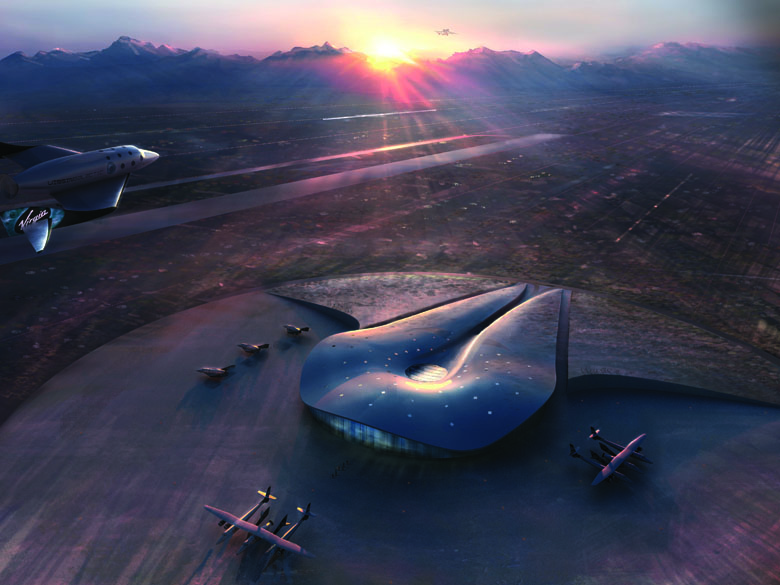Air travel is entering a new era. With China planning to open 78 new airports by 2020 and the number of passengers travelling globally set to hit 16 billion a year by 2050 (up from 2.8 billion today), the role aviation hubs play in cities, societies and economies will become more important than ever.
As a consequence, imaginative architects are going to be essential to make airports as efficient and attractive as possible. “The days of designing airports that are functional and concrete are over,” says Pat Askew, senior director of aviation and transportation for architectural company Gensler.
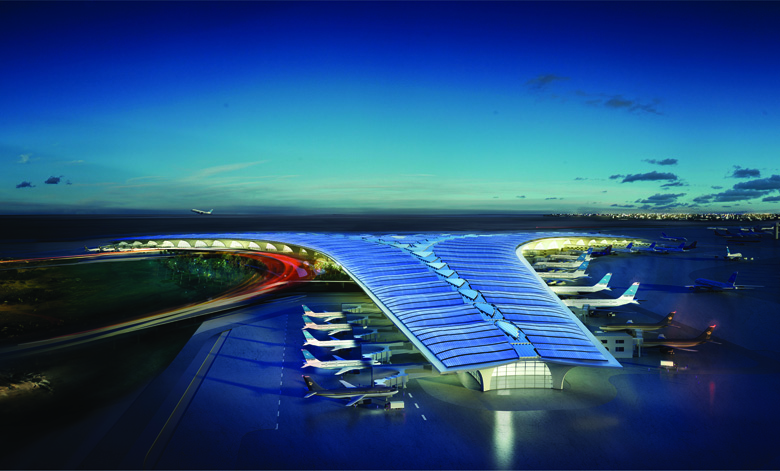
While in the past airports have generally been located outside of town, with terminals added as required, the economic ambitions of the BRIC nations are giving birth to a new kind of airport concept – the aerotropolis. As opposed to an airport that has only been geographically embraced by a city because of urban sprawl, an aerotropolis is a city that has been designed from scratch with an airport at its heart.
In a BBC Fast Track video report from April 2011, Greg Lindsay, co-author (with John D Kasarda) of Aerotropolis, says: “Do we think of airports as the ultimate nuisances and something we banish to the edge of our cities and then surround with steel mills and other horrible polluting things, or do we think of them as integral to the future and health of our city and build around them in intelligent ways?”
Such postmodern urban planning, which sees whole cities developed almost overnight with landing strips and air traffic control towers at the centre, are proving popular in the Middle East and Asia, where populations are booming and governments have the power to quickly make blueprints reality.
In the time the UK has been deliberating over a third runway at Heathrow, the aerotropolis of Songdo in South Korea, connected to Incheon airport by a 12km bridge, has risen from 6 sq km of reclaimed land to a gleaming confluence of tower blocks, with the aim of connecting more than one-third of the world’s population to the metropolis within 3.5 hours’ flight time.
When it comes to revamping or building new airports, using design to evoke a sense of place is another emerging trend. Raymond Kollau, founder of airlinetrends.com, says: “Passengers are looking for a local experience. When people transfer at [Amsterdam] Schiphol they will be there for two or three hours so they are offered a touch of the Netherlands – there is a branch of the Rijksmuseum, the Holland Boulevard, where you can have Dutch food, and an airport library where you can read translations of Dutch authors.”
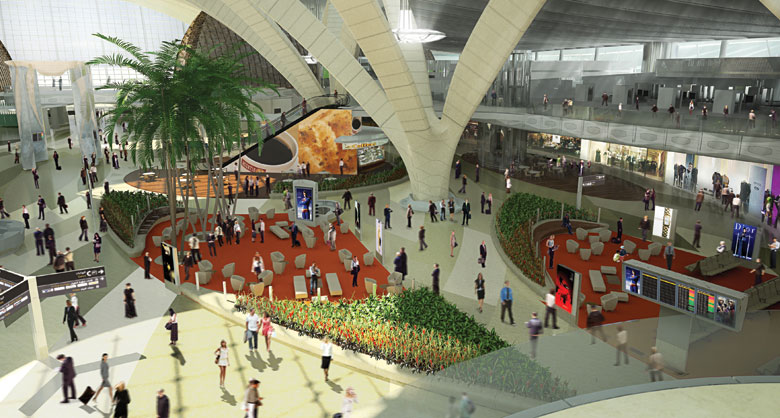
He also cites Copenhagen airport, which launched its CPH Apartment lounge in July last year – open to all travellers (at a fee of 169kr/£18), it is furnished in the style of an upscale Danish residence with a kitchen, dining room, lounge and study. Helsinki’s Almost@Home lounge, meanwhile, tempts visitors with woollen socks to relax in, on Artek Second Cycle sofas.
It’s not only happening in Europe. Tokyo Haneda’s new international terminal has opened an Edo-style market with paper lanterns and mock historic shops selling traditional food and handicrafts, while Denver airport has applied the concept to the overall look of its building, with a tent-like roof shaped as a series of white peaks as a nod to nearby snow-capped mountains.
Mouzhan Majidi, chief executive of Foster and Partners, which has designed airports such as Beijing International and Hong Kong Chek Lap Kok, says: “As international gateways, airports should reflect the spirit of the place they represent. Beijing International is a building born of its context. This is expressed in its dragon-like form and the traditional Chinese colours of the roof, as reds merge into golden yellows.
“Kuwait airport is similarly inspired by vernacular architecture – its design is responsive to one of the hottest inhabited environments on earth. Our research explored local shading and ventilation principles – the use of loggias and the shape and orientation of apertures in the thick walls, which allow daylight to penetrate interior spaces while ensuring a comfortable climate.”
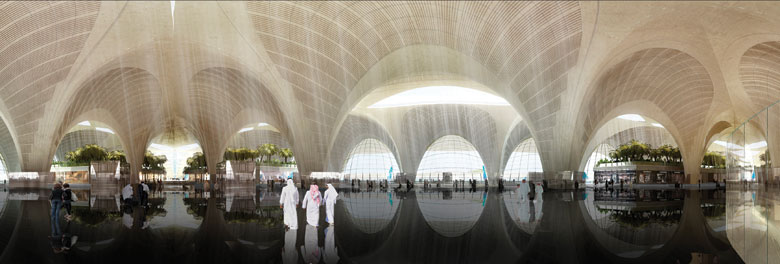
Askew from Gensler, which conceptualised San Francisco’s new Terminal 2 and JFK’s Jet Blue T5, agrees: “There is competition on where to fly and where to transfer – it’s civic pride. There is a desire to make things look different, be more welcoming and more indicative of the place in which it sits. One of the nicest projects Gensler did was Jackson Hall, Wyoming, in a national park – the airport looks like a lodge, but in a very contemporary way. It has lots of wood and a fireplace in the departure lounge. It’s easy to make a Disneyland theme park-style structure, but not easy to make something functional that also looks like it really belongs.”
While the aesthetics of an airport help to improve the experience of travellers, technology will continue to empower them. Online check-in may be old news but the impact it will have on the design of new airports is significant. Askew says terminals that were built a long time ago were designed according to very different criteria. “The change has been so rapid, the need for large areas for check-in has completely changed,” he says. “We are faced with a lot of big, empty halls that are unused, and very crowded airside areas.”
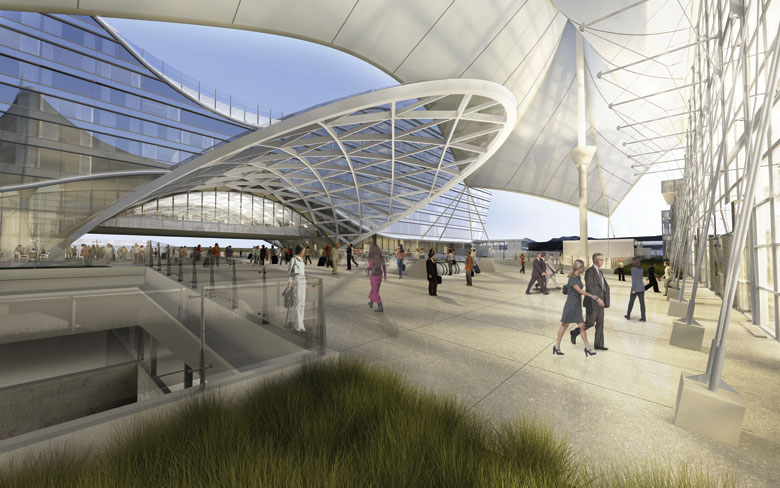
Paul Behan, head of passenger experience for trade body IATA, agrees: “If you look at Heathrow T5 compared with T4 ten years ago, in T4 there would have been about 150 desks and long queues leading to them, whereas T5 is designed on a wave concept – wave one for check-in at 95 self-service kiosks, wave two for those who have checked in online and need to drop a bag off, and wave three for check-in with an agent. It’s filtering out those people who need help from those who don’t.”
The smartphone is crucial to the technological changes taking place. Now you can download your boarding pass, change your seat, check your flight status, pay for upgrades and rebook flights all on your personal device. The growth in automated services at airports goes hand in hand with this, as biometric passport gates replace staffed immigration desks and airlines follow Lufthansa’s example of having self-boarding gates.
Security will also become more akin to something from Total Recall with the installation of IATA’s Checkpoint of the Future, which allows passengers to walk through a corridor of scanners with their hand luggage, and without taking out liquids or electrical items. (See “Changing lanes”.
In October, Denmark’s Billund airport worked with Thomas Cook to enable travellers to print their luggage tags at home, while Singapore Changi has partnered with IT firm SITA to provide end-to-end tracking, management and tracing of checked bags. In the US, Delta Air Lines scans every case that goes on to domestic flights, so that with the aid of its app, passengers will know if theirs has not been loaded. Kollau says: “Thanks to in-flight wifi, you can also start sorting out any luggage problem in the air using social media. There is a new interplay of things happening in the air and on the ground.”
The fact that Changi is embracing such technology is indicative of its dedication to offering the best airport experience possible – it has won the reader-voted Business Traveller award for Best Airport in the World for 25 years running. It also applies similar (if quirkier) innovations to enhance the maintenance of its public facilities. Tan Lye Teck, executive vice-president of corporate at Changi Airport Group, says: “Our Instant Feedback System (IFS) enables us to receive real-time feedback from customers at toilets, check-in, immigration and information counters as well as at retail and food and beverage outlets.
“For example, in washrooms equipped with the IFS, passengers are invited to rate the cleanliness. If they give a less than satisfactory rating, they are prompted to indicate the reason by selecting on-screen icons – for example, ‘wet floor’, ‘no toilet paper’, ‘dirty basin’. A mobile alert is then transmitted to the smartphone of the cleaning supervisor, who can initiate the necessary corrective action.”
If you find that a little weird, prepare yourself for the roll-out of 2D holographic staff who provide real-time instructions at security and boarding gates – the technology has already been trialled at Paris Orly, Manchester, Luton and Birmingham. There are even augmented reality apps that translate signs into your native language when you hold your phone up to them – Schiphol and Paris CDG already offer this to Chinese travellers. In August, Gatwick trialled a virtual fridge at its North Terminal so flyers could use their phone to scan items they wanted Tesco to deliver to their home for when they got back.
The democratising of luxuries formerly associated with club lounges is also going to be more common in the airport of tomorrow, with the likes of showers, free wifi, power points, comfortable seating and even snooze zones introduced in public spaces. The arrival of Yotel capsule hotels at Heathrow, Gatwick and Schiphol was the first good example of a hotelier capitalising on the power nap – you can book a 7 sqm-10 sqm room for four to 24 hours – but last summer Moscow Sheremetyevo took it a step further with its Sleep Box for long-haul transit passengers. Located near boarding gates, the 2m x 1.4m x 2.3m pods have two bunk beds and can be rented for between 30 minutes and several hours.
With all these innovations, the airport of the future is going to be a destination in itself. Shopping will continue to be a vital source of revenue, but as Askew notes, “there is only so much money a passenger will spend before they get on a plane”. So in addition, the emphasis will be on keeping them relaxed and entertained, something the 50-million capacity Changi is an expert in.
Karin Lui, premium content director of trendwatching.com, says: “Singapore is fantastic – it has so many facilities, food courts, gardens, cinema complexes and things for kids. Even when you are queuing for immigration they have pretty little waterfalls.” (That’s not even mentioning the rooftop pool and butterfly sanctuary.) The only problem is that if every airport becomes like this, no one will ever want to board their flight.
Ten trend-setting airport developments
1) INCHEON TERMINAL 2, SEOUL
Construction on the Gensler-designed terminal began last year, with completion due in 2017. It represents the third of four phases of development for the airport, with the last scheduled to be finished in 2020. By then it will have five runways and transport 100 million passengers a year (at the moment it is 44 million, with 66 million estimated in 2017). The 650,000 sqm “H”-shape terminal aims to be a retail destination in itself, much like T1, which generates more than US$400,000 a day at its Louis Vuitton store alone. There will also be indoor gardens, aviaries, running water, a spa, a hotel and event spaces. The translucent glass roof will let in filtered sunlight and it is hoped the building will achieve LEED (Leadership in Energy and Environmental Design) platinum status.
2) NEW DOHA INTERNATIONAL AIRPORT
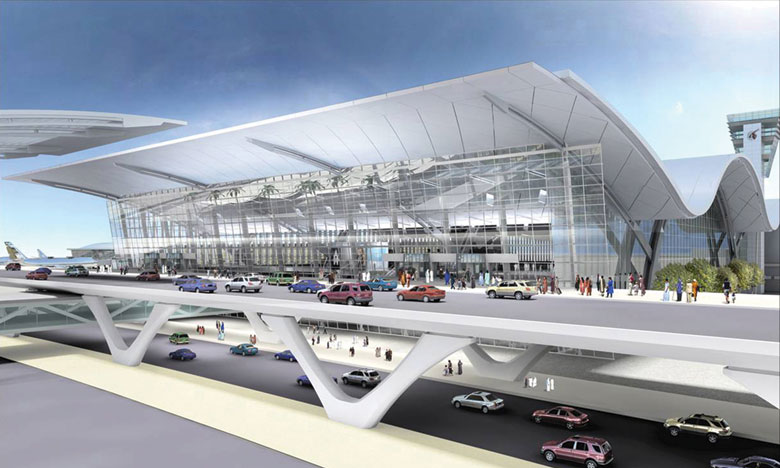
Built on more than 60 per cent reclaimed land, next door to the current Doha International airport that it will replace, the NDIA is to open by next summer. It will have an annual capacity of 50 million passengers across a three-storey terminal with 40,000 sqm of retail space and lounges. As well as an Emiri terminal for VIPs and a public mosque, the HOK Group-designed facility will have two luxury hotels and a spa. It is one of the first airports to be specifically designed to accommodate the A380 superjumbo, for which there will be six dedicated gates.
3) KUWAIT INTERNATIONAL TERMINAL 2
Conceptualised by Foster and Partners, construction on Kuwait’s new terminal began this year. When it is finished in 2016, it will handle about 13 million people a year, with the option of expanding to 50 million by 2035. Taking the form of a three-pointed star with the central space reaching an elevation of 25 metres, its single-roof concept (with tapered pale stone columns reminiscent of sails) is designed to make navigation from check-in to gate as easy as possible. It is hoped the project will achieve LEED gold status, thanks in part to rooftop solar panels.
4) BEIJING DAXING INTERNATIONAL
As if one state-of-the-art, 75 million-capacity airport isn’t enough, the Chinese capital is building a second one 46km south of Tiananmen Square. It will have an annual capacity of between 130 million and 200 million (mainly domestic traffic), making it the busiest in the world. Construction on the 55 sq km site (bigger than Bermuda) started late this year and is set for completion in 2017. It will have eight commercial runways and a high-speed city-centre train link.
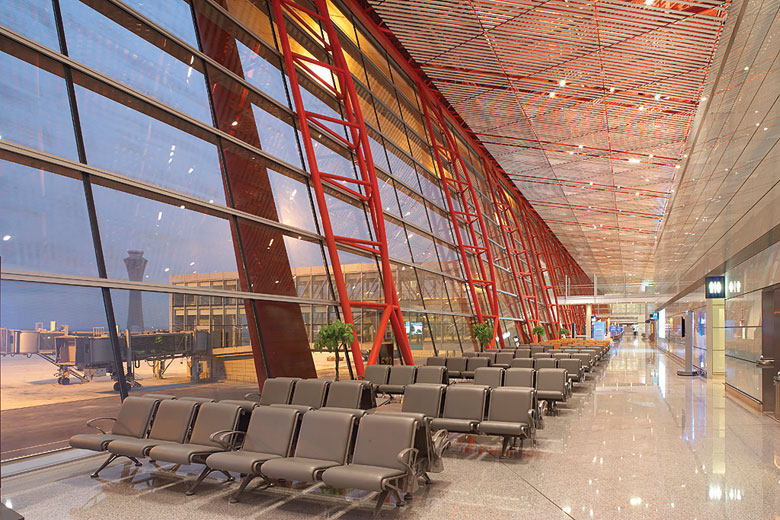
5) QUEEN ALIA INTERNATIONAL
Amman’s Queen Alila is being replaced with a new terminal that will increase capacity to nine million annually when it is complete next year. Its 127 domed rooftops were inspired by Bedouin tents, with columns creating the impression of palm trees. Designed by Foster and Partners, it will have natural ventilation, gardens and courtyards with pools, photovoltaic roof panels and rainwater harvesting.
6) ABU DHABI MIDFIELD TERMINAL
Work on this 700,000 sqm facility, set to open in 2017, is to start by the end of the year. The work of Kohn Pedersen Fox Associates, it will have more than 18,000 sqm of designer shops, 10,000 sqm of restaurants and 27,500 sqm dedicated to lounges, hotels and even a museum of heritage and culture.
7) DUBAI AL MAKTOUM INTERNATIONAL PHASE TWO
Phase one of the 24-hour airport opened to cargo in 2010, and once complete in about 2018, will be able to handle 160 million travellers a year – more than twice that of Heathrow – and four A380s at once thanks to five runways. The second phase is under way, with two passenger terminals being added. One of the most expensive airport projects in the world, with an estimated US$82 billion price tag, it will be the eventual base of Emirates.
8) BERLIN BRANDENBURG INTERNATIONAL
After numerous delays, the new Berlin Brandenburg is set to open in October next year, replacing existing airports Tegel and Schonefeld. Designed to handle up to 30 million passengers initially, with the addition of two satellite terminals it could accommodate up to 50 million. Inside there will be 108 self-service
check-in kiosks on top of 94 staffed desks, while outside, the nearby 109-hectare BER Business Park Berlin will be dedicated to convention centres and commercial and industrial outlets.

9) ZAGREB NEW TERMINAL
Designed by Zaha Hadid, work on Zagreb airport’s new terminal is to start in mid-2013 and is due for completion in 2016. The additional 67,700 sqm of space may not be much compared with the likes of Abu Dhabi and Beijing, but the white, curvilinear-looking structure, reminiscent of a network of sand-blasted bones, is extremely cutting-edge. It is described as “a distinctive, environmentally advanced building, organised through a series of flow lines, set in a tapestry-like configuration”, with “no clear distinction between floors, walls and roofs – the whole structure seamlessly integrates natural light, ventilation, access, signage and viewing areas”.
10) SPACEPORT AMERICA
The world’s first private spaceport, costing US$209 million, was unveiled in the New Mexico desert in October 2011 and has since seen a dozen suborbital flights launched. It signifies the first step into commercial space travel, the first instance of which is set for late next year with Virgin Galactic. Designed to achieve LEED gold certification, the building is cooled by “Earth tubes”, powered by solar panels, and ventilated with fresh air. The alien-looking Foster and Partners structure has been crafted to meld with the gentle curves of the surrounding landscape.
